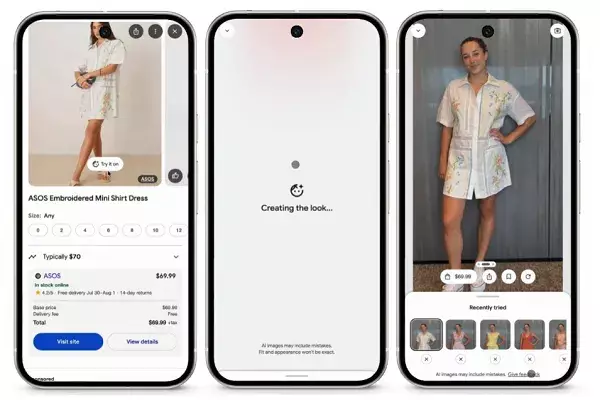Google’s latest developments signal a remarkable shift in how consumers will engage with digital retail. At the heart of this evolution is the groundbreaking virtual try-on feature that leverages artificial intelligence to simulate clothing on real users through selfies. Previously confined to beta testing within Search Labs, this innovative function is now accessible to the broader U.S. audience, promising to elevate the online shopping experience from mere browsing to immersive personalization. The capability to virtually wear items like gingham-print pants on one’s own likeness translates into a more accurate and confident purchasing process. It bridges the emotional divide many feel when buying clothes sight unseen, allowing shoppers to visualize how an item complements their body type, style, and personality.
This technological leap hints at a future where physical stores may no longer hold a monopoly on the tactile experience, as increasingly sophisticated AI tools allow consumers to virtually “try on” garments at home. The potential for this to reshape customer confidence and reduce return rates is enormous, making it an essential step forward for e-commerce platforms seeking to imitate in-store satisfaction digitally. The key factor, however, remains in the precision of these virtual fittings. Consumers will need to trust that the digital representations mirror real-world appearances closely. If Google’s algorithms succeed in rendering authentic previews, this could markedly diminish the physical barriers and hesitations consumers face when shopping online.
Smarter Price Tracking: Consumer Empowerment Through Data
Another transformative feature is the enhanced price tracking system, which aims to empower shoppers with real-time, personalized notifications. Users can now specify their ideal price points, sizes, and colors, transforming passive browsing into proactive engagement. The ability to set specific alerts for desired products increases transparency in pricing and optimizes savings. Given the complexity and frequency of online sales, this feature strips away the guesswork, allowing consumers to wait for precise deals without constantly monitoring multiple sites.
Google’s integration of the Shopping Graph—a vast network aggregating prices and product data from across the web—ensures that these alerts are timely and accurate. This approach not only benefits individual consumers but also pressures sellers to remain competitive, fostering a healthier marketplace characterized by transparency. For those who sift through countless sales and discounts, this advancement is nothing short of a game changer, transforming the consumer’s role from passive recipient to active price strategist.
Refining Search and Discovery Using Natural Language AI
The third pillar of Google’s new shopping tools revolves around natural language processing, enabling users to find products using conversational queries. Instead of relying solely on keywords, shoppers can now describe their desired items in terms of style, occasion, or specific features, and receive tailored search results powered by AI understanding. This intuitive matching simplifies the discovery process, especially for users who may struggle with traditional keyword searches or who have a vague idea of what they want.
This semantic search capability underscores a broader trend: AI-driven personalization is shifting from optional enhancement to necessity in e-commerce. For the consumer, this means more relevant suggestions, less frustration, and profound satisfaction when browsing. For retailers and platforms, it means an opportunity to better understand user intent, tailoring marketing and inventory strategies accordingly. With these AI tools, Google is effectively turning search into a dialogue—a conversation that understands context, nuance, and even mood.
Strategic Implications for the Future of Retail
Google’s aggressive rollout of these AI-powered shopping innovations signifies a deep recognition of the digital retail landscape’s evolving demands. As consumers become more digitally savvy and expectations for convenience grow, retailers must adopt similar technological solutions to stay competitive. These tools herald a future where online shopping is not just about finding products but experiencing them as if in a showroom, with the added benefit of being more personalized, efficient, and budget-conscious.
However, these advancements also pose questions about over-reliance on illusions and the digital simulation of physical experiences. If virtual try-ons become widely trusted, will consumers become less inclined to visit physical stores? Conversely, will brands that leverage such tools gain a significant edge in conversion rates? Only time will tell, but what’s clear is that AI’s infiltration into retail is no longer optional—it’s a strategic imperative.
By leading with these innovations, Google is actively shaping a future where online shopping feels less transactional and more human-centric. Their integration of AI into everyday retail activities points toward a world where technology seamlessly aligns with consumer desires, making shopping more intuitive, enjoyable, and ultimately more satisfying.

